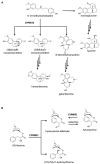Cytochrome P450 Enzymes as Key Drivers of Alkaloid Chemical Diversification in Plants
- PMID: 34367208
- PMCID: PMC8336426
- DOI: 10.3389/fpls.2021.682181
Cytochrome P450 Enzymes as Key Drivers of Alkaloid Chemical Diversification in Plants
Abstract
Plants produce more than 20,000 nitrogen-containing heterocyclic metabolites called alkaloids. These chemicals serve numerous eco-physiological functions in the plants as well as medicines and psychedelic drugs for human for thousands of years, with the anti-cancer agent vinblastine and the painkiller morphine as the best-known examples. Cytochrome P450 monooxygenases (P450s) play a key role in generating the structural variety that underlies this functional diversity of alkaloids. Most alkaloid molecules are heavily oxygenated thanks to P450 enzymes' activities. Moreover, the formation and re-arrangement of alkaloid scaffolds such as ring formation, expansion, and breakage that contribute to their structural diversity and bioactivity are mainly catalyzed by P450s. The fast-expanding genomics and transcriptomics databases of plants have accelerated the investigation of alkaloid metabolism and many players behind the complexity and uniqueness of alkaloid biosynthetic pathways. Here we discuss recent discoveries of P450s involved in the chemical diversification of alkaloids and how these inform our approaches in understanding plant evolution and producing plant-derived drugs.
Keywords: P450; alkaloid; catalysis; diversification; medicinal plants; oxidation; scaffold.
Copyright © 2021 Nguyen and Dang.
Conflict of interest statement
The authors declare that the research was conducted in the absence of any commercial or financial relationships that could be construed as a potential conflict of interest.
Figures





Similar articles
-
Mining of the Uncharacterized Cytochrome P450 Genes Involved in Alkaloid Biosynthesis in California Poppy Using a Draft Genome Sequence.Plant Cell Physiol. 2018 Feb 1;59(2):222-233. doi: 10.1093/pcp/pcx210. Plant Cell Physiol. 2018. PMID: 29301019 Free PMC article.
-
Impacts of diversification of cytochrome P450 on plant metabolism.Biol Pharm Bull. 2012;35(6):824-32. doi: 10.1248/bpb.35.824. Biol Pharm Bull. 2012. PMID: 22687470 Review.
-
The key role of cytochrome P450s in the biosynthesis of plant derived natural products.Plant Physiol Biochem. 2025 May;222:109695. doi: 10.1016/j.plaphy.2025.109695. Epub 2025 Feb 25. Plant Physiol Biochem. 2025. PMID: 40015195 Review.
-
Plant cytochrome P450s: nomenclature and involvement in natural product biosynthesis.Protoplasma. 2016 Sep;253(5):1197-209. doi: 10.1007/s00709-015-0884-4. Epub 2015 Sep 12. Protoplasma. 2016. PMID: 26364028 Review.
-
Opium poppy and Madagascar periwinkle: model non-model systems to investigate alkaloid biosynthesis in plants.Plant J. 2008 May;54(4):763-84. doi: 10.1111/j.1365-313X.2008.03438.x. Plant J. 2008. PMID: 18476877
Cited by
-
Multi-Omics Analysis Reveals the Resistance Mechanism and the Pathogens Causing Root Rot of Coptis chinensis.Microbiol Spectr. 2023 Feb 21;11(2):e0480322. doi: 10.1128/spectrum.04803-22. Online ahead of print. Microbiol Spectr. 2023. PMID: 36809123 Free PMC article.
-
A developmental gradient reveals biosynthetic pathways to eukaryotic toxins in monocot geophytes.Cell. 2024 Oct 3;187(20):5620-5637.e10. doi: 10.1016/j.cell.2024.08.027. Epub 2024 Sep 13. Cell. 2024. PMID: 39276773
-
Integrative Analysis of Elicitor-Induced Camptothecin Biosynthesis in Camptotheca acuminata Plantlets Through a Combined Omics Approach.Front Plant Sci. 2022 Mar 24;13:851077. doi: 10.3389/fpls.2022.851077. eCollection 2022. Front Plant Sci. 2022. PMID: 35401649 Free PMC article.
-
Biosynthesis of strychnine.Nature. 2022 Jul;607(7919):617-622. doi: 10.1038/s41586-022-04950-4. Epub 2022 Jul 6. Nature. 2022. PMID: 35794473 Free PMC article.
-
Isolation and Characterization of the Genes Involved in the Berberine Synthesis Pathway in Asian Blue Cohosh, Caulophyllum robustum.Plants (Basel). 2023 Mar 28;12(7):1483. doi: 10.3390/plants12071483. Plants (Basel). 2023. PMID: 37050109 Free PMC article.
References
-
- Benayad S., Ahamada K., Lewin G., Evanno L., Poupon E. (2016). Preakuammicine: a long-awaited missing link in the biosynthesis of monoterpene indole alkaloids. Eur. J. Org. Chem. 2016, 1494–1499. 10.1002/ejoc.201600102 - DOI
Publication types
LinkOut - more resources
Full Text Sources
Other Literature Sources

